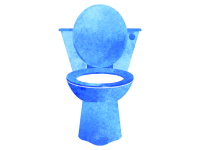Water Saving Advice
Water Saving Advice
Use water wisely
Water use accounts for 6% of UK greenhouse gas emissions. 1% of this is from the treatment & transport of water and waste water, and the remaining 5% is from the energy used to heat water in the home*.
So saving water can save energy, which can help save money on your energy bills – it’s good for your pocket and the planet.
From drinking tap water to washing, cooking, cleaning or flushing, we all use water every day. It also needs energy to heat water for showers, baths and washing dishes.
Here’s a few simple steps you can take to help save water & energy in and around your home and help protect a precious resource.
*CIWEM, 2013, A Blueprint For Carbon Emissions Reduction in the UK Water Industry.
Garden Water Saving Video
Watch our video featuring Royal Botanic Garden Expert Kirsty Wilson
Watch hereSaving Water Outside
 Did you know? A hosepipe can use enough water in 30 minutes to fill five bath tubs. Top Tip: Use a bucket and sponge to wash the car to help save water.
Did you know? A hosepipe can use enough water in 30 minutes to fill five bath tubs. Top Tip: Use a bucket and sponge to wash the car to help save water.

Use a watering can instead of a hose and water plants early in the morning or late in the evening, this way less water will evaporate and more will go to the plant roots. Alternatively, you can fit your hosepipe with a trigger nozzle so it only runs when you need it.

Use a water butt! Did you know? Rainwater is better for your plants as there is nitrogen in the rain which helps plants thrive. A small Scottish roof collects over 45,000 litres of water each year, that’s more than enough to keep your water butt topped up!
For more expert advice on how to help save water in and around your garden, visit rhs.org.uk
Saving Water in the Kitchen

Save on your energy bills by filling the kettle with only the water you need, you’ll also save time waiting for the kettle to boil!

Remember to wash your dishes in a basin or bowl instead of under a running tap, or if using a dishwasher wait for a full load and use the eco setting to help save not only water but energy too! Did you know? A tap left running while washing dishes or fruit and vegetables for 10 minutes can use around 110 litres of water which disappears straight down the drain.

Fully load your washing machine and dishwasher and use the eco-setting where possible to save water and energy. Washing clothes at 30 degrees rather than 40 degrees reduces your machine’s energy consumption by 57%.
Saving Water in the Bathroom

Showers and baths use the most amount of water in the home (30%), and make up around a fifth of the average household energy bill, knocking one minute off your shower can save over 2,600 litres of water and 27kg of CO2 per person, each year.

Turning off the tap when brushing your teeth & shaving can save 5 litres a minute and over 3,700 litres a year per person.

Found a dripping tap? A dripping tap can waste over 5,500 litres of water a year so make sure taps are turned off properly or replace the washer.
Leaky Loos
 A leaking toilet can waste between 215 and 400 litres of water every day. Between 5 and 8% of toilets are leaking, and it is most common with dual flush toilets.
A leaking toilet can waste between 215 and 400 litres of water every day. Between 5 and 8% of toilets are leaking, and it is most common with dual flush toilets. So if your toilet is leaking, get it fixed as quickly as possible.
Leaky Loo Test
Alternatively, if you have easy access to your cistern put food dye or a dye tablet in the cistern and wait 20 minutes, if the water in the toilet bowl ends up coloured then you have a leak.
Assumes a semi-detached, 3 bedroom gas heated house with gas price 4.17p/kWh and electricity price 16.36p/kWh, unless otherwise stated. Correct as of October 2020.










